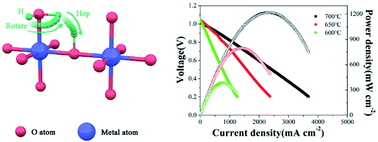Mo-doping allows high performance for a perovskite cathode applied in proton-conducting solid oxide fuel cells†
Abstract
Experimental studies integrated with first-principles calculation revealed that the Mo-doping strategy allows the traditional Ba0.5Sr0.5Co0.8Fe0.2O3−δ (BSCF) perovskite cathode to show improved hydration ability and proton migration ability, leading to a much larger power output when applied in fuel cells. In addition, the CO2-tolerance ability of the material was improved with the Mo-doping strategy, suggesting that the new route coupled high performance with good stability and provided a promising way of designing a perovskite cathode for proton-conducting solid oxide fuel cells (H-SOFCs).



 Please wait while we load your content...
Please wait while we load your content...